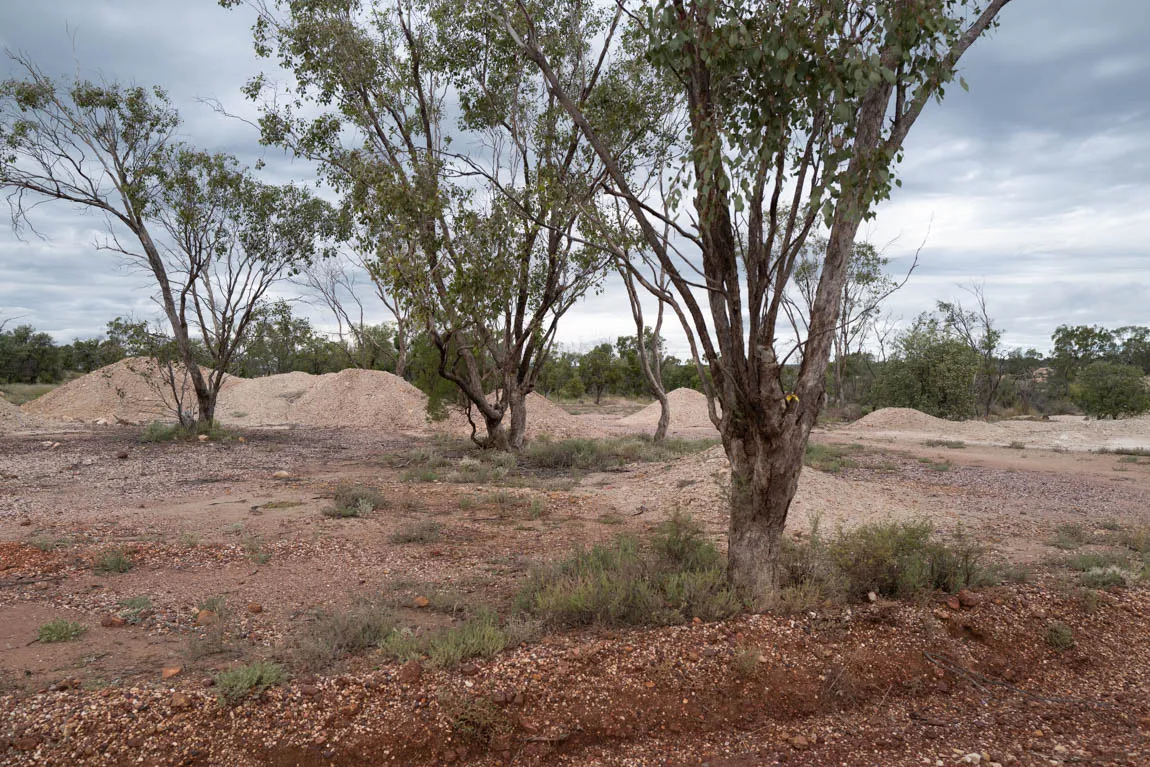Just my luck that Lightning Ridge has had about 20% of its annual rainfall in the two days since I have been here. And to make matters worse there was an icy wind blowing today.
I decided to carry on regardless and had a really interesting morning driving out to the Three Mile Opal Field-one of the oldest and most productive opal mining areas around Lightning Ridge. The road was a mess -big potholes and very muddy- but I managed to get there and back although the Mini is now filthy. I did get some really odd looks from the drivers and passengers in hunking great SUVs as they drove past me splashing mud all over Elf.
Below is a photo is typical of what the whole mining field looks like. The Dept of Mines does not want open cut mining so mining continues as it has always been -individual miners going down small shafts and chipping away at the dirt. Finding an opal is really a matter of pure chance. One miner can be digging out dirt from his mine and find nothing for weeks or even months whereas the miner in the mine shaft next to him can strike it rich on the second day. And when I say strike it rich it is literally rich as the black opals found in this area are extremely valuable. Some miners are multi millionaires but they continue mining and living in little tin shacks on the mining fields because they are addicted to the opal chase.
The conical mounds are the dirt dug out from the shafts. It is either pulled out in a chain of buckets in a conveyor system or blown out with a blower. It is then tumbled with water-most likely in an old truck mounted cement mixer-where the clay is washed off and then the residual of gravel is carefully examined for opals.The conical mounds are dirt waiting to be tumbled or the discarded tumbled dirt.
You cannot just walk onto the mining area and start scratching through the mounds yourself-fossicking as it is called-is most definitely frowned on and out here frowned on has various interpretations depending on whose mound you are fossicking. There are literally thousands of open mine shafts out here and finding a body in one would be impossible. There are some designated fossicking sites on private property and I was told that a tourist found an opal valued at A$3000 on one such site last week.
Opals form in a material known as potch and it is relatively easy to find potch with traces of opal in it whilst fossicking. I can attest to this I actually found a piece of potch after just a few minutes of fossicking yesterday.
I would also commend spell checker for true diligence in auto correcting my spelling of potch to pitch at least 12 times whilst I typed the above paragraph.
After driving the Mini through potholes and mud to my surprise I came to a large modern shed where a volunteer-Bob-was modifying a projector stand to take a brand new HD video projector to show videos onto the side of the shed which is next to hopefully what will be the site of the Australian Opal Centre (AOC) in a dramatic Gleenn Murcutt designed building. The Centre will show the history of the mining in the area and also show some of the many opalised fossils found in the area. The site is ready and the plans have been approved. They are just waiting for the funding to come through......
I had a very interesting chat with Bob-below- for about an hour. He told me that he had studied philosophy at university before becoming hooked on opal mining. He and his wife had bought up a family for 11 years in the stone building below. I assume he now lives in town in a house with more amenities-like running water and electricity.
I do understand that having a beard is not mandatory for opal miners or retired opal miners but the chances of finding a opal miner without one are actually less than are the chances of finding an opal.
And finally to support my rating of Lightning Ridge as really weird where else in Australia would you find a rusting prewar car chassis on a piece of land on the main street opposite the post office?






No comments:
Post a Comment